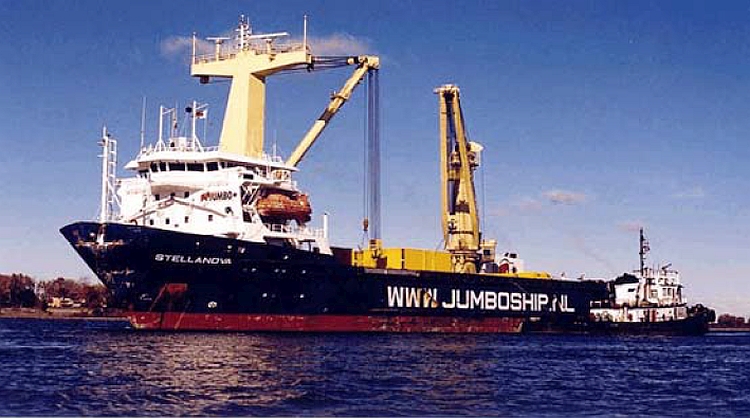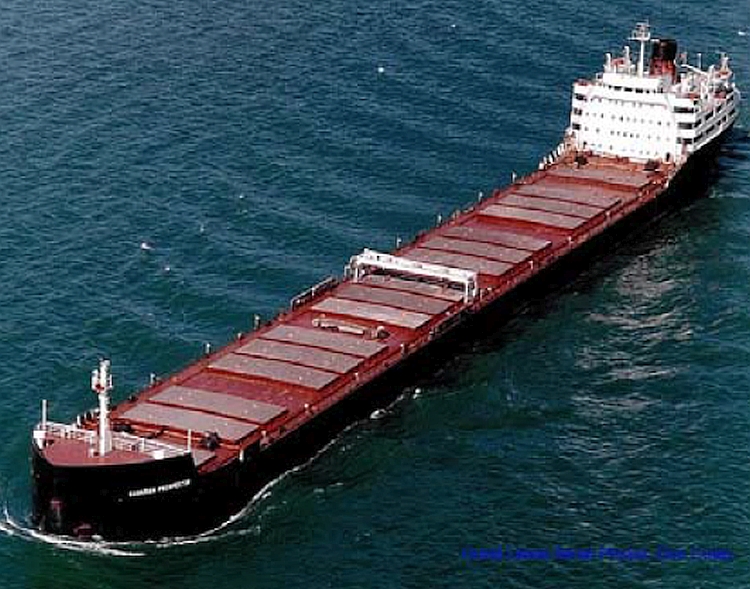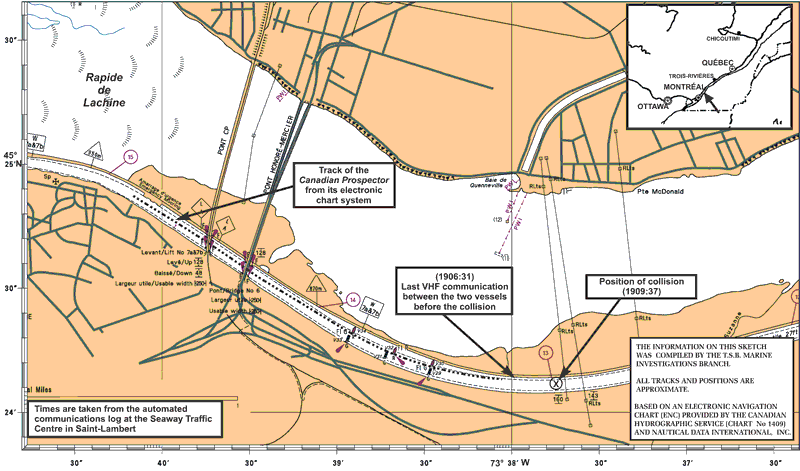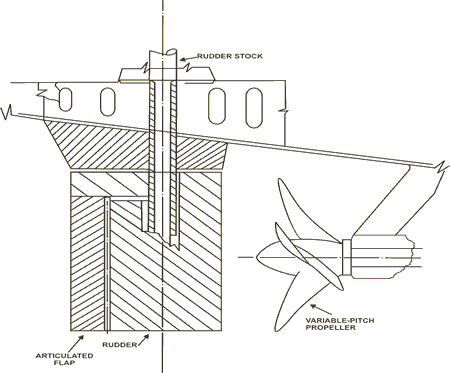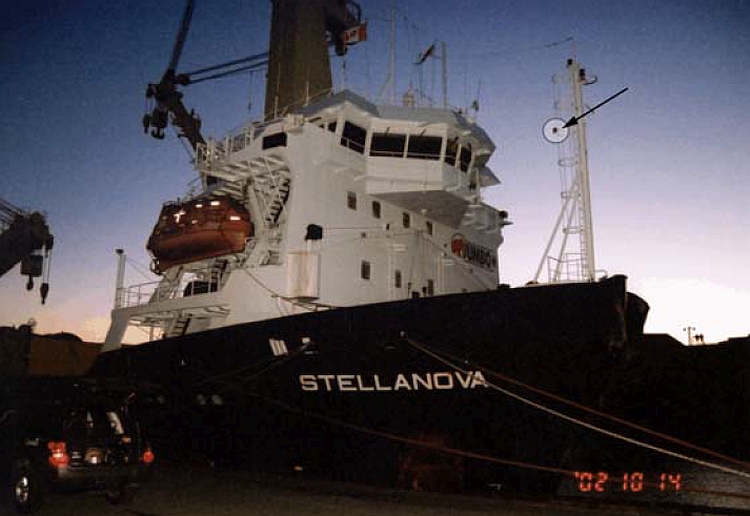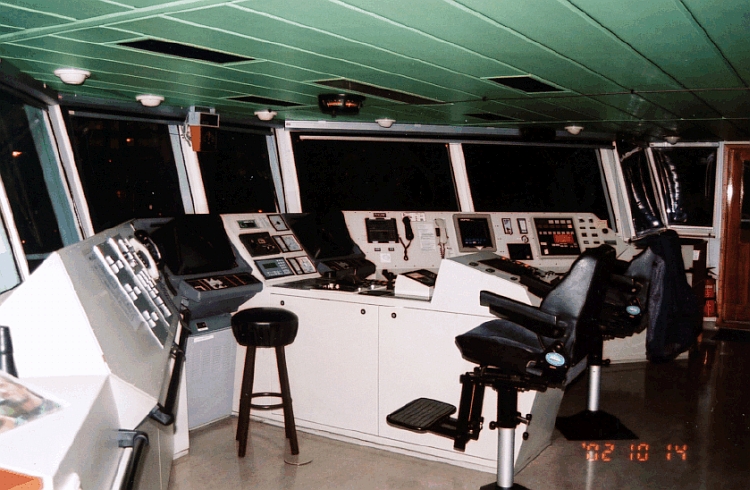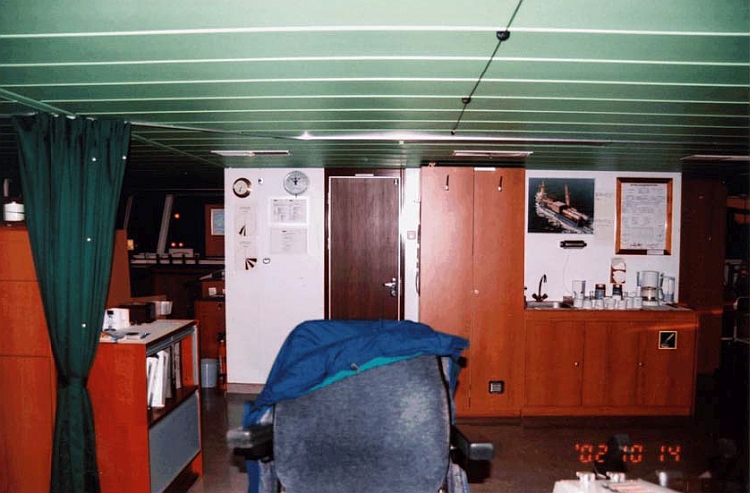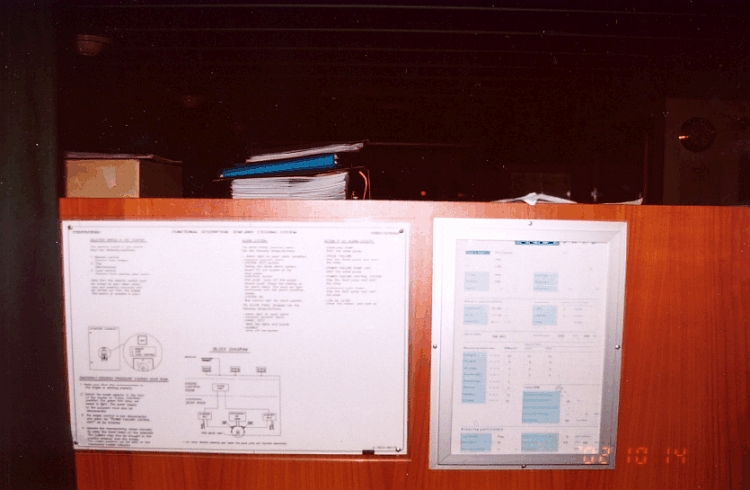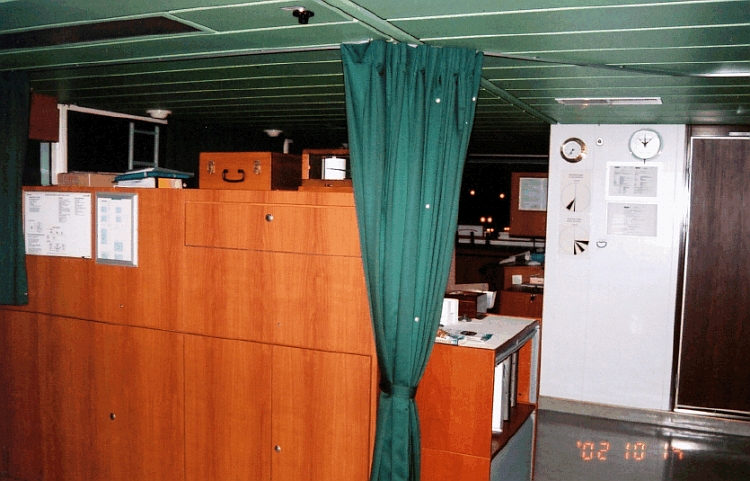Collision
Between the great lakes bulk carrier
Canadian Prospector
and the heavy lift ship Stellanova
St. Lawrence Seaway, Quebec
The Transportation Safety Board of Canada (TSB) investigated this occurrence for the purpose of advancing transportation safety. It is not the function of the Board to assign fault or determine civil or criminal liability. This report is not created for use in the context of legal, disciplinary or other proceedings. See Ownership and use of content. Masculine pronouns and position titles may be used to signify all genders to comply with the Canadian Transportation Accident Investigation and Safety Board Act (S.C. 1989, c. 3).
Summary
At approximately 1850 eastern daylight time on 12 October 2002, the upbound Stellanova was going west through the South Shore Canal on the St. Lawrence Seaway while the downbound Canadian Prospector was preparing to enter the South Shore Canal eastbound just after transiting Lake St. Louis.
As it approached Mile 12, the Stellanova was on the south side of the channel when the pilot called the Canadian Prospector and arranged a starboard-to-starboard passing. The master of the Canadian Prospector concurred with the arrangement and manoeuvred the vessel towards the north side of the channel. The Stellanova was manoeuvred in order to keep it on the south side of the channel, but it sheered towards the centre of the channel, and the Stellanova and the Canadian Prospector collided.
Both vessels sustained significant damage. The Stellanova struck the bank, causing minor pollution, which was eventually brought under control by St. Lawrence Seaway authorities. One member of the Stellanova crew sustained minor injuries as a result of the impact.
Factual information
Particulars of the vessels
| Name | "Canadian Prospector" | "Stellanova" |
|---|---|---|
| Official number | 305421 | 18689 |
| Port of registry | Canada | Holland |
| Flag | Canada | Holland |
| Type | Great Lakes bulk carrier | heavy lift ship |
| Gross tonnageFootnote 1 | 18 526 metric tons | 4962 metric tons |
| Length | 222.5 m | 95.72 m |
| Draught (forward) | 7.6 m | 5.90 m |
| Draught (aft) | 7.91 m | 5.95 m |
| Built | 1964, Sunderland, U.K. Rebuilt 1979, Halifax, N.S. | 1996, Ysselwerf, Holland |
| Propulsion | Low-speed diesel engine, 5595 kW, one fixed-pitch propeller | Diesel engine, 2640 kW, one variable-pitch propeller |
| Cargo | Bulk soybeans | Petrochemical equipment |
| Crew | 21 | 13 |
| Owners | Upper Lakes Group Inc.Toronto, Ontario | Stella V.O.F. Rotterdam, the Netherlands |
The Stellanova
The Stellanova is a heavy lift ship with a deadweight of 5212 tonnes and hoisting apparatus mounted on the starboard side. The accommodation is forward, and the vessel has an "integrated bridge" wheelhouse.
The Canadian Prospector
The Canadian Prospector is a Great Lakes bulk carrier with bridge, accommodation and main engine aft of the cargo holds. The bridge is equipped with an electronic chart system (ECS).
Sequence of events
On 12 October 2002, the Stellanova was transiting the South Shore Canal bound for the Great Lakes. A Seaway pilot had had the conduct of the vessel since the St. Lambert lock. The first mate was the officer of the watch, and a helmsman was at the helm. On Lake St. Louis, the Canadian Prospector was bound for Port-Cartier, Quebec. The master was at the controls of the vessel in the presence of an officer of the watch and a helmsman.
As it exited the Côte-Sainte-Catherine lock around 1819 eastern daylight time,Footnote 2 the Stellanova called the Canadian Prospector, which was just passing St. Nicolas Island. The call was made on very high frequency (VHF) radiotelephone channel 8.Footnote 3 The two vessels agreed to meet downstream of buoys V29 and V30 referred to as the "sticks" in their communication.
Around 1827, the Canadian Prospector was entering the South Shore Canal while the Stellanova reduced speed to about two knots on approaching the Côte-Sainte-Catherine dock due to a containment boom deployed around the Algosound. At 1842, the Canadian Prospector broadcast a courtesy call to advise traffic that it was off Church Point, and at 1855, when the vessel passed under the Honoré-Mercier Bridge, its speed was 6.9 knots and its heading 122° (T).
In the meantime, the master of the Stellanova relieved the first mate. He took up a position at a workstation beside the Global Maritime Distress and Safety System (GMDSS), and started working on tasks unrelated to navigation. Upstream at Mile 12, the pilot decreased propeller pitch by moving the gradient control lever from 4 to 3. Within the next few seconds, the Stellanova sheered to port. There is conflicting information regarding the helm orders given by the pilot, i.e. whether the wheel was ordered hard over to starboard, or starboard five degrees, followed by midship. At 1906:19, the pilot called the Canadian Prospector and arranged a starboard-to-starboard passing. The master of the Canadian Prospector concurred with the arrangement and indicated that the vessel's position was east of buoys V29 and V30.
A short time later, the Stellanova sheered towards the centre of the channel. The pilot ordered the helmsman to steer hard-to-port, but the Stellanova continued the sheer to starboard. At 1906:31, the Stellanova advised the Canadian Prospector that it was coming back to the north side of the channel and that the two ships should effect passage port to port. The Canadian Prospector firmly rejected the proposal and immediately requested confirmation of their earlier starboard-to-starboard arrangement. The Stellanova responded that its main engine was operating full astern.
The Canadian Prospector was steered closer to the north side of the channel edge to give the Stellanova maximum sea room to prevent a collision. However, at 1909:37, the two vessels collided. The angle of impact was estimated to be 120°. On impact, the Canadian Prospector swung to port and its over-the-ground speed decreased from 4.1 knots to 2.3 knots. At the time of impact, the Stellanova was pushed towards the south side of the channel, where it struck the edge. The rudder and rudder stock were warped, causing hydraulic oil to leak into the Seaway. At 1912, the Seaway station at Beauharnois received a brief damage report.
The Canadian Prospector was able to continue on its route to the Côte-Sainte-Catherine lock approach wall. The Stellanova was towed to Montréal Harbour. Seaway traffic was held up for almost 14 hours to allow a response crew to contain the Stellanova's hydraulic oil spill.
Conduct of navigation
While transiting the Seaway, the bridge team of the Stellanova consisted of a pilot, an officer of the watch, in this case the first mate, and a helmsman. The usual pilot/master information was exchanged when the pilot arrived on board.
A short time before the collision, the officer of the watch was replaced by the master. The master had been sitting at a desk with a computer, adjacent to the conning position, attending to other duties. Shortly before the vessel sheered the first time, the master was at the chart table trying to locate buoys V29 and V30, referred to as "the sticks," a terminology used by the pilot in communications with the Canadian Prospector. It had been previously agreed to meet below "the sticks."
The pilot had the conduct of the vessel and executed the necessary speed changes and course orders until the vessel sheered initially to port. The master joined the pilot near the conning position quickly after the first sheer. By that time, the vessel was coming near, and parallel to, the south shore. The master then decreased the pitch to slow the vessel.
As both vessels came within sight of one another, the Stellanova sheered a second time, this time to starboard. The pilot immediately ordered hard-to-port helm and the master increased the thrust to help correct the heading. Just before the collision, the master left the conning position to warn the crew of the imminent impact using the public address system; the pilot, in the meantime, put the pitch to full astern.
On board the Canadian Prospector, the master, who was at the controls, looked after routine communications with Marine Communications and Traffic Services while transiting the Seaway, and he maintained close communications with the Stellanova upon entering the South Shore Canal until the collision.
Manoeuvrability of the Stellanova
Unlike the rudder and propulsion system on a conventional vessel, the Stellanova is equipped with a Becker rudder and a variable-pitch propeller (see Figure 2). To make the vessel more manoeuvrable, the rudder has an articulated flap on its after edge. The helm can be turned up to 35° (at sea) or 45° (in port). The flap deflects automatically in the same direction as the rudder. This increases the helm angle, and the rudder-to-flap ratio can be as high as 2:1. The efficiency of the rudder gives the ship good manoeuvrability in different conditions. However, the investigation revealed that, when the propeller pitch is decreased quickly with the vessel moving forward, the vessel tends to swing unexpectedly to one side or the other, and the helmsman cannot predict to which side it will swing.
Ergonomics on the bridge of the Stellanova
On the Stellanova, the wheelhouse is laid out as an integrated bridge. From the conning position, the view over the starboard quarter is limited due to the hutch on the chart table (see photos at Appendix A) and the crane on the starboard side. Visibility directly aft is also reduced due to the access to the lower accommodation decks (see photos at Appendix A). During navigation, to have an aft view, a person has to be stationed either on the port side of the bridge or on one of the wings.
Visibility forward from the bridge is good. The blue steering light is mounted level with the bridge and aft of the foremast (Photo 3 shows the position of the blue light).
Because the distance between the bridge and the forward mast is short, the blue light is not a good visual steering reference.
Bridge team on the Stellanova
The bridge team consisted of a master, a helmsman and a Seaway pilot. Communication was on an informal basis, and there was little communication regarding navigation. The master and pilot had received training on bridge resource management (BRM).
Conditions for exemption from pilotage
In November 1999, the Minister of Transport directed the Great Lakes Pilotage Authority (GLPA) to implement more strict conditions regarding pilotage exemptions. The GLPA consulted the Canadian Shipowners Association, and subsequently submitted to Transport Canada (TC) a draft amendment to the Great Lakes Pilotage Regulations. On 15 April 2001, the Minister of Transport asked the GLPA to withhold its amendment proposal pending a review of the conditions governing exemptions to mandatory pilotage for waters under GLPA jurisdiction, conducted in accordance with the Pilotage Risk Management Methodology (PRMM). The PRMM review, which was to have been completed in early 2002, related to the possibility of exempting domestic vessels from mandatory pilotage, and it considered such elements as training and certificates.
During the PRMM review, the Canadian Shipowners Association developed and presented an extensive training program taking into account standards and requirements for simulation training, BRM and electronic chart display and information system (ECDIS) training, on-board local knowledge training, a formal evaluation process, an approved trainer, and a documentation/auditing capability. This training program is not recognized by the GLPA. This program is followed by the owners of Canadian Prospector to train their officers.
To date, the owners of exempted ships produce affidavits stating that the officer has completed the minimum number of voyages required but do not specify the exact number of voyages made by the officer, nor are they required to do so.
Pilotage exemption
The master on the bridge of the Canadian Prospector at the time of the events leading up to the collision was also in charge of pilotage. He was duly certified to do so by way of an exemption.
Pilot training
Pilotage authorities recognize the value of using a manoeuvre simulator in their pilot training. To meet its objectives, the GLPA set up a training program, in collaboration with an approved training centre. The program period will be spread over five years favouring the use of a manoeuvre simulator, as proposed in the syllabus.
The syllabus indicates that the scheduled simulator exercises are conducted essentially using mathematical models of existing Canadian vessels, and there is no provision for simulations for vessels with non-traditional handling characteristics like the Stellanova. This is a unique type of vessel with a bridge well forward and unusual ergonomics.
Furthermore, the syllabus does not take into account manoeuvring with a Becker rudder in emergency/threatening situations and normal practical experience will not afford a pilot the opportunity to practice its use.
Analysis
Bridge Resource Management principles - Stellanova
The essence of BRM is the effective use of all available human and physical resources to complete an operation safely. BRM addresses issues such as vigilance and people's attitude towards managing operational tasks, stress, and risks. Optimizing the management of these elements has a direct impact on the following four factors critical to the successful outcome of any operation:
- situational awareness - recognizing and defining the nature of the problem;
- metacognition - reflecting on and judging one's own cognitive activities or decisions;
- shared mental models - involving others in the problem-solving process; and
- resource management - understanding tasks to be performed, their priorities, and required and available resources.
Although the master of the Stellanova was acting as the officer of the watch and was therefore responsible for navigation, he was doing administrative tasks for some of the time the vessel was navigating in the confined waters of the South Shore Canal. In the crucial seconds before the first sheer, only the pilot had a clear mental model of where the ship was in relation to the channel and to the downbound Canadian Prospector. As the master was not actively sharing the conning position with the pilot nor was he actively involved in the navigation of the vessel, the environment on the bridge was not conducive to promoting good communications or a shared mental model. Just before the first sheer, the master was preoccupied with trying to find "the sticks" on the chart. Once the sheer had begun, helm orders were still given by the pilot, but pitch control was now assumed by the master. Just before the collision, pitch control was again assumed by the pilot.
Keeping a close watch on the movement of a vessel is key to safe navigation in confined waters and is a very important factor for the execution of manoeuvres. It is therefore essential that each member of the bridge team clearly understands his/her role and ensures that all information relating to the conduct of the vessel is conveyed to other team members. This was not done.
Non-observance of the principles of BRM such as the absence of effective communication or the lack of a shared mental model have been identified in past TSB reports as a contributing factor in several occurrences. We note that these conditions persisted on the Stellanova even though both key members of the bridge team had received BRM training.
Loss of control of the Stellanova
In close quarters, close watch of the movement of a vessel must be kept to ensure vessel safety. In order to do this, the bridge team must be familiar with the operation of all on-board navigation equipment and be cognizant of the limitations of the equipment.
Shortly after reducing the pitch setting of the Stellanova with the variable-pitch control lever, the pilot realized that the vessel had moved closer to the south side of the channel. From that point on, the bridge team performed manoeuvres but did not succeed in regaining control of the vessel.
Vessels with variable-pitch propellers have a tendency to go off course if the propeller pitch is reduced too quickly.Footnote 4 The control lever on the Stellanova is relatively small and has no detents for each gradient. It is therefore difficult to accurately set the propeller pitch at a specific gradient especially at night and during a rapidly developing situation. Since the Stellanova has a tendency to yaw unpredictably to port or starboard when the propeller pitch is decreased quickly, and since the propeller pitch was reduced before the vessel sheered, the difficulties associated with the setting of the gradient may, in part, account for the vessel's behaviour prior to the occurrence.
The suction effect on the banks is analogous to squat, except that it works in the horizontal plane rather than the vertical plane. When a vessel moves through the middle of a shallow channel, the flow of water on either side of the hull is more or less symmetrical, and the control and response of the rudder are not affected. However, when the vessel tracks parallel to but not on the centreline of a shallow and confined channel, the flow of water between the vessel and the near bank accelerates, causing a reduction in pressure, and the vessel is drawn towards the near bank. The strength of the suction effect depends largely on the speed of the vessel, the depth of the water, and how close the vessel is to the bank.
When a vessel is subject to such a suction effect, the best practice to extricate the vessel from the situation is to reduce speed. In this occurrence, the propeller pitch was increased to neutralize the sheer. The subsequent sheer to starboard is similar to the bank suction effect.
In this instance, the vessel's wheelhouse was well forward and the blue (steering) light was not a good visual reference for observing vessel movement. Consequently, a view of the stern was essential to maintain a better appreciation of the vessel's behaviour/response. As the wheelhouse and chart room arrangements restricted view aft, cues necessary to maintain visual reference and situational awareness were not readily available from the conning position. This made navigation from the central conning position more difficult.
It is possible that the Stellanova sheered towards the south side of the South Shore Canal due to a reduction in thrust in conjunction with the difficulties associated with vessel ergonomics.
In confined waters, there is little margin for error, and the onset of sheering would make regaining control of a vessel difficult. Consequently, close coordination between the pilot and the master and close monitoring of the vessel's progress by both is essential to ensure a comprehensive and shared mental model. Following the sheer to port, the vessel could not be steadied in the centre of the channel. This would suggest that there was ineffective coordination between the pilot and the master - the master having in-depth understanding of the vessel's manoeuvring characteristics and the pilot having extensive local knowledge. The pilot had some experience on vessels fitted with Becker rudders under normal operating conditions, unassociated with emergency situations.
Manoeuvres by the Canadian Prospector
After the Canadian Prospector had entered the South Shore Canal, it had to maintain sufficient speed to be able to steer. Since there was not enough room to manoeuvre, a collision could not be avoided by the two vessels.
Evaluation of conduct on the Canadian Prospector
Information gathered during the investigation indicates that the principles of BRM were applied on the Canadian Prospector.
Communication between vessels
It is the responsibility of mariners to use the radio frequencies that are monitored by the traffic regulator. To manage traffic, the regulator must assess the traffic situation as a whole and must therefore be advised of all transmissions concerning navigation. Communications between the Stellanova and the Canadian Prospector were on VHF channel 8, which is not monitored by St. Lawrence Seaway traffic regulators.
Findings
Findings as to causes and contributing factors
- It is possible that the Stellanova sheered towards the south side of the South Shore Canal due to a reduction in thrust in conjunction with vessel ergonomics.
- The Stellanova's master was not actively involved in the navigation of the vessel during the transit, and the environment on the bridge was not conducive to promoting good communications or a shared mental model.
- Due to the bank suction effect on the south side of the channel, the Stellanova sheered a second time towards the middle of the channel.
- The Canadian Prospector did not have enough manoeuvring room to avoid the impact.
Findings as to risk
- Communications related to navigational safety are effected on frequencies that are not monitored by the Seaway.
Other findings
- Although some mariners are trained in bridge resource management (BRM), the principles of BRM are not fully put into practice.
- The pilot had not received hands-on training on similar vessels in non-threatening environments or in emergency situations. This training could have led to a better appreciation of non-traditional ship-handling characteristics and evasive manoeuvres.
This report concludes the Transportation Safety Board's investigation into this occurrence. Consequently, the Board authorized the release of this report on .
